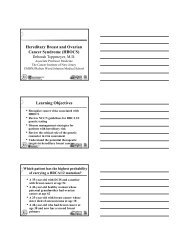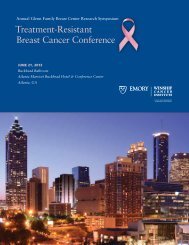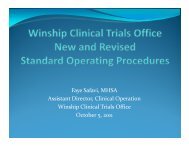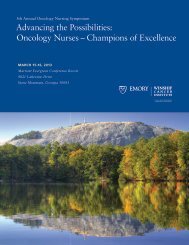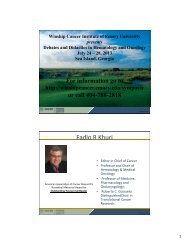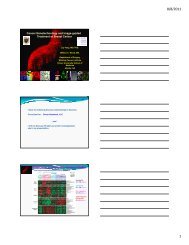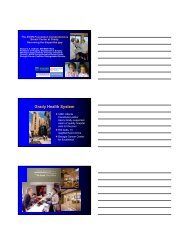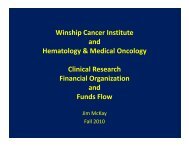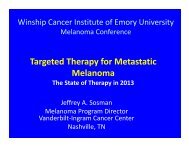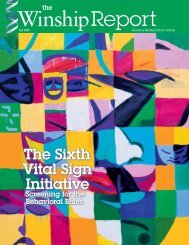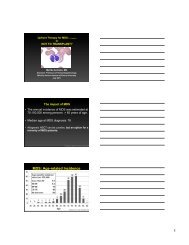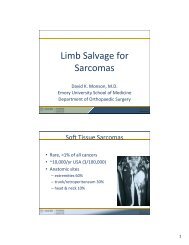How I Treat Waldenstrom Macrobulinemia - Winship Cancer Institute ...
How I Treat Waldenstrom Macrobulinemia - Winship Cancer Institute ...
How I Treat Waldenstrom Macrobulinemia - Winship Cancer Institute ...
You also want an ePaper? Increase the reach of your titles
YUMPU automatically turns print PDFs into web optimized ePapers that Google loves.
7/17/2012<br />
<strong>How</strong> I <strong>Treat</strong>: Waldenström Macroglobulinemia<br />
Leonard T. Heffner, Jr., M.D.<br />
<strong>Winship</strong> <strong>Cancer</strong> <strong>Institute</strong> of Emory University<br />
What I need to know before starting<br />
treatement for Waldenström<br />
• Does the patient really have WM.<br />
• Is there an indication for starting treatment<br />
• What risk factors are present<br />
• Is there a standard treatment<br />
• What are the treatment options<br />
• Is there a clinical trial available<br />
• Should the patient receive maintenance<br />
• Is there a role for stem cell transplant<br />
Demographics<br />
Incidence Age-adjusted : 3.8/million persons/yr.(1500/yr)<br />
Amyloidosis: 8/mil persons/yr<br />
Myeloma: 40/mil persons/yr<br />
Age: 65-73 yo (median at Dx)<br />
Gender: Males: 5.4/mil<br />
Females: 2.7/mil<br />
Race: Caucasian- 4.1/mil<br />
African-American- 1.8/mil<br />
Wang H, et al. <strong>Cancer</strong> 2011;doi:10.1002/cncr.26627<br />
1
7/17/2012<br />
106.5 vs 94 mos<br />
p = 0.37<br />
Kastritis E, et al. AmJHem 2011;86:479<br />
120 mos vs not reached<br />
p = 0.987<br />
Kastritis E, et al. AmJHem 2011;86:479<br />
1944: Jan Waldenström described 2 pts with<br />
lymphadenopathy, but also oranasal<br />
bleeding, anemia, thrombocytopenia,<br />
increased viscosity, elevated ESR, normal<br />
bone survey, and bone marrow showing<br />
predominantly lymphoid cells.<br />
Waldenström, J: Incipient myelomatosis or essential hyperglobulinemia with<br />
fibrinogenopenia--A new syndrome Acta Medica Scand 117:217, 1944.<br />
2
7/17/2012<br />
WHO 2008: The Mature B-cell Neoplasms<br />
• Lymphoplasamacytic lymphoma<br />
a. Bone marrow infiltration by small lymphocytes,<br />
plasmacytoid cells, and plasma cells<br />
b. diffuse, interstitial or nodular pattern of bone<br />
marrow infiltration<br />
c. Immunophenotype: CD5-,CD10-, usually CD23-,<br />
CD19+,CD20+,sIg+<br />
1. Waldenström macroglobulinemia<br />
IgM monoclonal gammopathy of any<br />
concentration<br />
The IgM Disorders<br />
• Waldenström (WM):<br />
-IgM monoclonal gammopathy(any amt)<br />
-BM infiltration with lymphoplasmacytic<br />
cells<br />
• Smoldering WM:<br />
->3 g/dL monoclonal protein<br />
and/or<br />
->10% BM lymphoplasmacytic cells<br />
but also no evidence of symptoms or lab<br />
findings due to the disease<br />
The IgM Disorders<br />
• IgM MGUS:<br />
-IgM monoclonal protein
7/17/2012<br />
Diagnostic Approach for Suspected WM<br />
-SPEP with immunofixation<br />
-Quantitative immunoglobulins<br />
-24hr urine for electrophoresis<br />
-Beta-2 microglobulin and LDH (for prognostic scoring)<br />
-Bone marrow with cytogenetic analysis and FISH<br />
-CT imaging of chest/abdomen/pelvis (bone survey only if suspected myeloma)<br />
-Serum viscosity<br />
-Based on clinical presentation: consider cryoglobulins, cold agglutinins, other<br />
medical causes of anemia, tissue stains for amyloid, detailed fundoscopic exam,<br />
hepatitisB and C, anti-MAG and anti-GM1 antibodies<br />
Indications for treatment of WM<br />
Bone Marrow/Node Related<br />
1. Hgb
7/17/2012<br />
International prognostic scoring system<br />
for Waldenström<br />
Variables<br />
Age >65<br />
Hgb 7.0<br />
For pts. needing therapy<br />
Score Med surv 5-yr surv<br />
Low 0-1 142.5 mos. 87%<br />
except age<br />
Int 2 98.6 mos. 68%<br />
or age<br />
High >3 43.5 mos. 36 %<br />
nl LDH = 94 mos<br />
Inc LDH = 36 mos<br />
Morel P, et al. Blood 2009;113:4163<br />
Kastritis E, et al Leu Res 2010;doi:10;1016<br />
Making the decision to treat WM<br />
• There is NO one standard of care regimen.<br />
• Does the patient meet the criteria for<br />
symptomatic disease<br />
• <strong>How</strong> urgent is response needed<br />
- immediate<br />
- non-immediate<br />
• Are there any high-risk features<br />
• Is the patient a potential candidate for stem cell<br />
transplant<br />
<strong>Treat</strong>ment Options in WM<br />
Single Agents<br />
• Rituximab<br />
• Chlorambucil<br />
• Fludarabine<br />
• Cladribine<br />
• Bortezomib<br />
• Cyclophosphamide<br />
• Thalidomide<br />
• Bendamustine<br />
Combinations<br />
• Flu or Clad/Rituxan<br />
• FCR<br />
• R-CHOP<br />
• R-CVP<br />
• R-CD<br />
• Benda/Rituxan<br />
• Bortez/Rituxan/Dex<br />
• Stem cell Transplant<br />
And plasmapheresis<br />
5
7/17/2012<br />
The IgM Flare<br />
• A rapid rise in IgM level following rituximab (up to<br />
60% incidence)<br />
• May aggravate pre-existing hyperviscosity or<br />
precipitate new sxs of hyperviscosity<br />
• Also occurs with combination drug therapy, but<br />
less common with bortezomib<br />
• Use TPE (with albumin) prophylactically for IgM<br />
level >4000mg/dL or any symptomatic viscosity<br />
• Generally 1-3 TPE required to reduce IgM by 30-<br />
60%, but follow IgM levels. Follow with additional<br />
planned therapy within 1 week optimally.<br />
Bystander release of IL-6 by Monocytes may<br />
account for the Rituximab IgM flare.<br />
Rituximab<br />
IVIg<br />
FcγRIIA<br />
IgM (ng/ml)<br />
IL-6<br />
IL-6R<br />
Monocytes<br />
WM-LPC<br />
IgM<br />
Treon, SP. Used by permission<br />
Single-Agent <strong>Treat</strong>ment in WM<br />
Regimen No. Responses (%)<br />
>PR >MR CR<br />
CB 46-128 70-75 NR 2<br />
Cladribine 16-46 43-94 NR 2<br />
Fludarabine 28-183 30-36 NR 0-3<br />
Rituximab 17-69 32-48 55-69 0<br />
Bortezomib 10-27 48-60 59-85 0-4<br />
Thalidomide 20 25 25 0<br />
Rourke M, et al Leuk&Lymp, 2010;51:1779-92. (modified)<br />
6
7/17/2012<br />
Combination <strong>Treat</strong>ment in WM<br />
Regimen<br />
Responses (%)<br />
(No. pts 31-72) >PR >MR CR<br />
Flu/Ctx 55-78 NR 0<br />
Flu/R 82 95 5<br />
FCR 74 79 12<br />
Clad/Ctx 84 NR 5<br />
Mel/Ctx/Pred 77 NR NR<br />
Mel/Ctx/CB/Pred 74 NR 26<br />
Ctx/R/Dex 74 83 7<br />
R-CHOP 91 NR 9<br />
Rourke M, et al Leuk&Lymp, 2010;51:1779-92.(modified)<br />
Phase III Trials in WM<br />
Yr.<br />
pub<br />
Regimen No. Pop. Yrs to<br />
complete<br />
Kyle 1999 Daily vs intermit CB 46 Upfront 22<br />
Leblond 2001 Flu vs CAP 92 Rel/Ref 4<br />
Buske 2009 CHOP vs R-CHOP 48 Upfront 3<br />
Rummel 2009 R-CHOP vs BR 41 Upfront 6<br />
Owen NYR Flu vs CB 337 Upfront 8.5<br />
Rourke M, et al Leuk&Lymp, 2010;51:1779-92.(modified)<br />
Event Analysis in WM Trials<br />
• Numerous studies with small numbers of<br />
patients; absence of randomized trials<br />
• Patient populations not uniform: untreated, rel/ref,<br />
no. of prior lines of treatment; age gps; risk stratification<br />
• Lack of uniform response criteria or not given:<br />
PR vs MR vs VGPR vs nCR<br />
• Absence of consistent defined events: PFS, EFS, TTNT,<br />
DOR<br />
• Definitions of response not consistent: IgM vs M-<br />
spike; bone marrow; nodal response<br />
7
7/17/2012<br />
Phase III Study of Chlorambucil vs<br />
Fludarabine in Untreated WM<br />
• 414 patients: 337 WM (34 MZL, 43 LPL)<br />
• Chlorambucil 8mg/m2 x10d every 4 wks<br />
• Fludarabine 40mg/m2 x5d every 4 wks<br />
• Med age: 68; study required 8.5 years to complete<br />
WM CB FLU signif<br />
PFS 27mo 35 mo<br />
TTF 19 mo 38 mo<br />
5yr OS 65% 70% ns<br />
CR+PR* 40% 51% p=.06<br />
Owen, R. United Kingdom * CR = 3.6%<br />
Phase II Study of Fludarabine,<br />
Cyclophosphamide and Rituximab in Untreated<br />
and Prev <strong>Treat</strong>ed WM<br />
• 43 pts. (65% untreated); med age 65<br />
– Flu 25mg/m2 IV d 2-4<br />
– Cyclophos 250mg/m2 IV d 2-4<br />
– Rituximab 375mg/m2 IV d 1<br />
• ORR: 79%<br />
-12% CR - 21% VGPR<br />
- 42% PR - 4% MR<br />
• 87.6% med TTP at med of 24.8 mos.<br />
• Toxicity: a) 88% grade 3-4 neutropenia with<br />
44% lasting med of 7 months<br />
b) 3 deaths from infection<br />
c) 2 developed myelodysplastic syndrome<br />
Tedeschi A, et al. <strong>Cancer</strong> 2012:118:434<br />
Randomized Phase III Trial of CHOP vs R-<br />
CHOP in Previously <strong>Treat</strong>ed LPL/WM<br />
• 64 with LPL and 48 with WM<br />
CHOP R-CHOP<br />
ORR 60% 91%<br />
CR 4% 9%<br />
TTF 22 mos 64 mos<br />
OS* 33 mos 73 mos<br />
* maint. Interferon-alpha<br />
Buske C, et al. Leukemia 2009;23:153<br />
8
7/17/2012<br />
Phase III Randomized Trial of R-CHOP vs<br />
R-Bendamustine as Front-line <strong>Treat</strong>ment in<br />
Indolent Lymphoma<br />
• 513 Evaluable patients with FL, MZL,<br />
MALT, and WM (41)<br />
BR(22) R-CHOP(19)<br />
ORR 95% 95%<br />
PFS NR 35 mos*<br />
Dec IgM ~500 ~900<br />
Relapse 18%(4) 58%(11)<br />
Deaths 1 4<br />
Rummel, MJ Germany<br />
* p=0.0024<br />
Phase II Study of Bortezomib(Velcade) and<br />
Rituxan as Primary Therapy for WM<br />
• BZ 1.6mg/m2 IV d 1,8,15 for 28d cycles x6<br />
• Rituximab 375mg/m2 IV weekly cycles 1&4<br />
• 26 pts: CR- 1(4%) nCR-1(4%)<br />
88%<br />
PR- 15(58%) MR-6(23%)<br />
• Med DOR and TTP = NR (>12mos)<br />
• Toxicity: (grade 3 or 4) neutropenia(12%),<br />
anemia(8%), low platelets(8%). No significant<br />
peripheral neuropathy<br />
Ghobrial I, et al. AmJHem; 2010;85:670<br />
E1A10: <strong>Treat</strong>ment<br />
for Primary or<br />
Relapsed WM<br />
9
7/17/2012<br />
<strong>Treat</strong>ment Options in WM<br />
Investigational agents<br />
1. Rad-001<br />
mTOR inhibitors<br />
2. Temsirolimus<br />
3. Perifosine- AKT inhibitor<br />
4. Btk inhibitors<br />
5. Pomalidomide- immune modulator<br />
5. Panobinostat- HDAC inhibitors<br />
What about maintenance<br />
Retrospective review comparing maintenance rituximab vs observation in 248<br />
pts with rituximab-naïve WM who responded to a rituximab-containing regimen<br />
No. PFS<br />
Obs 162 28.6mos<br />
Ritux 86 56.3 mos<br />
P=0.0001<br />
Treon SP, et al. BritJHaem. 2011;154:257<br />
10
7/17/2012<br />
Is Transplantation a Reasonable Option<br />
Yes<br />
1. Avoid toxicities of repeated drug therapy<br />
2. Limited duration of response to salvage<br />
therapy<br />
3. Infrequent poor adverse cytogenetics-i.e., drug<br />
resistance mutations<br />
4. Low proliferative rate-i.e, less kinetically active<br />
5. Outcomes favorable- a deep and durable<br />
response to a single dose of myelosuppresive<br />
therapy<br />
Selected Largest Series of Autologous SCT in WM<br />
Source No. Med<br />
age<br />
Response<br />
>PR CR<br />
RFS<br />
EBMTR 158 49 85% 22% 40%<br />
5 yr<br />
Giralt 24 50 96% 38 <br />
OS<br />
69%<br />
5 yr<br />
France 17 54 100% 12% 53%<br />
10mo<br />
France 2 32 56 med<br />
32 mo<br />
UK 9 56 100% 34% 43%<br />
4 yr<br />
65%<br />
25+ mo<br />
58%<br />
5 yr<br />
73%<br />
4 yr<br />
Modified from Gertz MA, et al. Bone Marrow Transp 2011;doi.1038/bmt.2011.175<br />
11
7/17/2012<br />
<strong>How</strong> I <strong>Treat</strong> Waldenström<br />
Macroglobulinemia<br />
Waldenström Macroglobulinemia<br />
Leonard T. Heffner, Jr., M.D.<br />
<strong>Winship</strong> <strong>Cancer</strong> <strong>Institute</strong> of Emory University<br />
12
7/17/2012<br />
Demographics<br />
Age-adjusted incidence: 3.8/million persons/yr.<br />
Amyloidosis: 8/mil<br />
Myeloma: 40/mil<br />
Gender: Males: 5.4/mil<br />
Females: 2.7/mil<br />
Race: Caucasian- 4.1/mil<br />
African-American- 1.8/mil<br />
WHO 2008: The Mature B-cell<br />
Neoplasms<br />
• Lymphoplasmacytic lymphoma<br />
a. Immunophenotype: CD5-,CD10-,<br />
CD19+,CD20+,sIg+<br />
b. Bone marrow infiltration by small<br />
lymphocytes, plasmacytoid cells, and plasma cells<br />
c. diffuse, interstitial or nodular pattern of bone<br />
marrow infiltration<br />
1. Waldenström macroglobulinemia<br />
IgM monoclonal gammopathy of<br />
any concentration<br />
Overall Survival<br />
per ISSWM<br />
Before 2000<br />
Overall Survival<br />
per ISSWM After<br />
2000<br />
13
7/17/2012<br />
<strong>Treat</strong>ment Options in WM<br />
Single Agents<br />
• Rituximab<br />
• Chlorambucil<br />
• Fludarabine<br />
• Cladribine<br />
• Bortezomib<br />
• Cyclophosphamide<br />
• Thalidomide<br />
• Bendamustine<br />
Combinations<br />
• Flu/Rituxan<br />
• FCR<br />
• R-CHOP<br />
• R-CVP<br />
• Benda/Rituxan<br />
• Bortez/Rituxan/Dex<br />
• Ctx/Dex/Rituxan<br />
• Stem cell Transplant<br />
Phase II Trial of Single Agent<br />
Panobinostat(LBH589) in Rel/Ref WM<br />
• 27 patients enrolled<br />
• 30mg flat dose PO 3x/wk; 1 cycle = 4wks<br />
• Med no. of cycles = 4 (1-12)<br />
• Response: 15(60%) 6 PR, 9 MR, 9 SD<br />
• Toxicity: Grade 3 or 4: anemia, neutropenia, low<br />
platelets, GI bleed, elevated blood sugar.<br />
Grade 2: low platelets, anemia, fatigue<br />
• Protocol amended to decrease starting dose to 25mg<br />
3x/wk<br />
Ghobrial, I. Boston<br />
14



